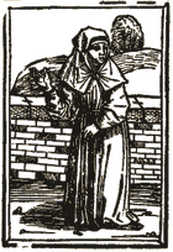
In late medieval Europe, groups of women called beguines assembled in twos and threes, or in large communities, to practice the religious life. They lived simply, served the poor and sick, and sometimes engaged in business. But unlike nuns, they didn’t take vows. So what did it mean to be a beguine? This episode takes on that question, on which both medieval authorities and modern scholars have disagreed.
Podcaster: Lucy
Further Reading
Letha Böhringer, “Beginen und Schwestern in der Sorge für Kranke, Sterbende und Verstorbene: Eine Problemskizze,” in: Organisierte Barmherzigkeit: Armenfürsorge und Hospitalwesen in Mittelalter und früher Neuzeit, ed. Artur Dirmeier (Verlag Friedrich Pustet, 2010), 127-55. Jennifer Kolpacoff Deane, “From Case Studies to Comparative Models: Würzburg/Vienne,” in: Labels and Libels: Naming Beguines in Northern Medieval Europe, ed. Letha Böhringer, (Brepols, 2014) 53-82. Beate Sophie Gros, Das Hohe Hospital in Soest (ca. 1178-1600): Eine prosopographische und sozialgeschichtliche Untersuchung, Aschendorff, 1999. Herbert Grundmann, Religious Movements in the Middle Ages: The Historical Links Between Heresy, the Mendicant Orders, and the Women's Religious Movement in the Twelfth and Thirteenth Century, with the Historical Foundations of German Mysticism. Translated by Steven Rowan, University of Notre Dame Press, 1995. Christine Guidera, “The Role of the Beguines in Caring for the Ill, the Dying, and the Dead," in: Death and Dying in the Middle Ages, ed. Edelgard E. DuBruck and Barbara I. Gusick (New York: Peter Lang, 1999), 51-72. Elizabeth Makowski, A Pernicious Sort of Woman: Quasi-Religious Women and Canon Lawyers in the Later Middle Ages, Catholic University of America Press, 2005. --------------- “When is a beguine not a beguine? Names, Norms, and Nuance in Canonical Literature," in: Labels and Libels: Naming Beguines in Northern Medieval Europe, ed. Letha Böhringer, (Turnhout: Brepols, 2014) 83-98. Amy Nelson, “Soror nostra: Religious Identity among Premonstratensians and their Patrons,” Presentation at the Medieval Academy of America annual meeting, Boston, MA, February 25-27, 2016. Eva Gertrud Neumann, Rheinisches Beginen- und Beghardenwesen: Ein Mainzer Beitrag zur religiösen Bewegung am Rhein. Mainzer Abhandlungen zur mittleren und neueren Geschichte 4, A. Hain, 1960. Dayton Phillips, Beguines in Medieval Strasbourg: A Study of the Social Aspects of Beguine Life, Stanford University Press, 1941. Walter Simons, “Beginnings: Naming Beguines in the Southern Low Countries, 1200-50,” in: Labels and Libels: Naming Beguines in Northern Medieval Europe, ed. Letha Böhringer, (Turnhout: Brepols, 2014) 9-52. --------. Cities of Ladies: Beguine Communities in the Medieval Low Countries, 1200-1565, University of Pennsylvania Press, 2001. Music: "Evening Melodrama" by Kevin Macleod (www.incompetech.com)
0 Comments
Leave a Reply. |
Site Map |
© 2013-2024 Footnoting History. All rights reserved.
Footnoting History and the Footnoting History logo
are trademarks of Footnoting History, NY. Footnoting History operates under a SAG-AFTRA Micro-Monetized Podcast Agreement. |

